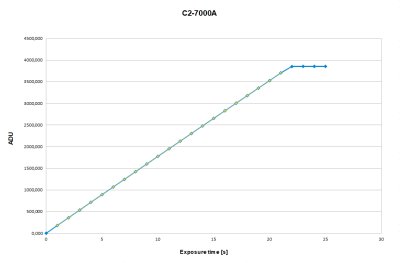|
Small pixel size and the resulting limited dynamic range (number of
electrons every pixel can hold before it saturates) of the CMOS
sensors concern especially astronomers focused to research
applications. Very low read noise of CMOS sensors offsets this problem
when the camera read noise determines the S/N ratio — CMOS cameras often offer better theoretical S/N than the
CCD ones. Such situation is typical e.g. for narrow-band imaging in
astronomical photography. But when the noise introduced by sky
background overgrows the other noise sources and becomes dominant
(this is typical for photometry and other research applications),
small pixels can become the limit.
When the new C1+7000 and C2-7000 cameras are used in 2 × 2 binned mode, resulting pixel size 9 μm equals to the pixel size
of the G2-1600 CCD camera, widely popular and beloved by astronomers
focused to scientific applications. The original resolution of
7 MPx is reduced to approx.
1.75 MPx by 2 × 2 binning, which is still slightly more than
1.6 MPx of G2 camera
thanks to greater IMX428 area compared to KAF-1603ME CCD. So, the
C2-7000 looks like the very promising replacement of the “research
workhorse” G2-1600 camera.
| |
G2-1600 |
C2-7000 |
C2-7000 (2 × 2
binning) |
| Sensor |
Kodak KAF-1603ME (CCD) |
Sony IMX428 (CMOS) |
Sony IMX428 (CMOS) |
| Number of pixels |
1,536 × 1,024
(1.5 M) |
3,216 × 2,208
(6.8 M) |
1,608 × 1,104
(1.7 M) |
| Sensor area |
13.8 × 9.2 mm |
14.8 × 9.9 mm |
14.8 × 9.9 mm |
| Pixel size |
9 × 9 μm |
4.5 × 4.5 μm |
9 × 9 μm |
| Pixel capacity |
100,000 e- |
25,000 e- |
100,000 e- |
| Quantum efficiency |
80 % |
68 % |
68 % |
| Read noise |
~13 e- RMS |
~5.3 e- RMS |
~10.7 e- RMS |
| Dynamic range (signal/noise) |
1 : 7,692 |
1 : 4,094 |
1 : 9,720 |
| Digitization range |
16-bit (0..65,535) |
12-bit (0..4,094) |
14-bit (0..16,376) |
| Image download time |
0.95 s (Mark II) |
0.05 s (USB3) |
0.05 s (USB3) |
| Sensor cooling |
-50 °C |
-42 °C |
-42 °C |
Comparing the key parameters of G2-1600 and C2-7000
cameras One of the key requirements for the scientific camera is linear
response to light. Only then we can rely on the count values of pixels
(called ADU or DN) correspond to the amount of light each pixel
received. This is crucial for precise measuring of brightness of
celestial objects. While the linearity of the cameras equipped with
3.45 μm pixels is nearly perfect, linearity of the IMX428 CMOS
sensor with 4.5 μm is excellent without any compromises.

C2-7000A camera linearity Especially medium size and large amateur telescopes with focal
length a meter or greater cannot utilize very small pixels of many
CMOS sensors and images become over-sampled, at last for longer
exposure times (planetary imagers, employing very short exposures in
some form of “lucky-imaging” techniques, prefer small pixels
even for very long focal lengths).
C1+ cameras are described in detail in separate article. This article also covers main
differences among C1, C1+ and C2 cameras. C2 cameras are described in
detail in the here.
| 